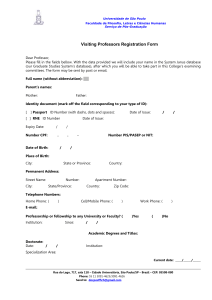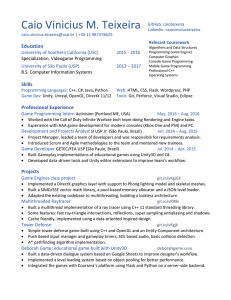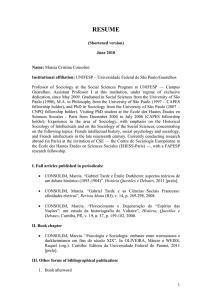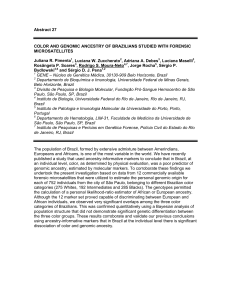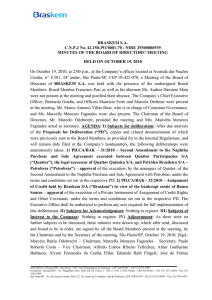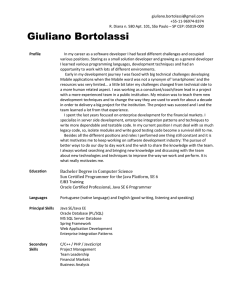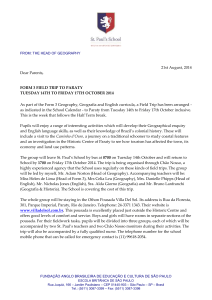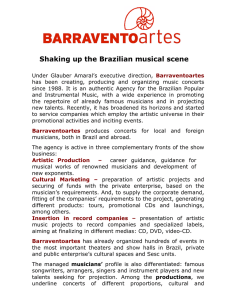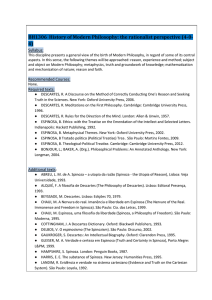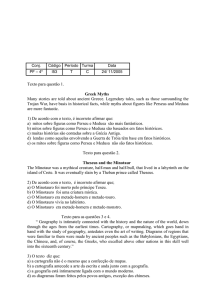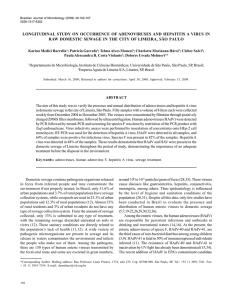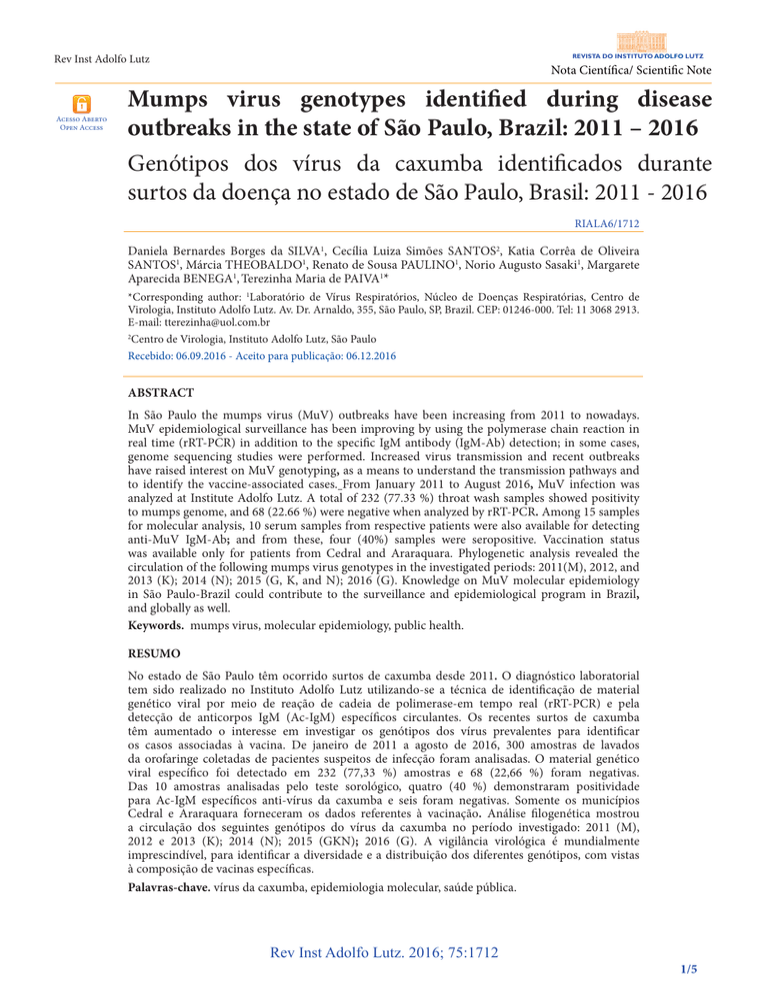
Rev Inst Adolfo Lutz
Acesso Aberto
Open Access
Revista do Instituto Adolfo Lutz
Nota Científica/ Scientific Note
Mumps virus genotypes identified during disease
outbreaks in the state of São Paulo, Brazil: 2011 – 2016
Genótipos dos vírus da caxumba identificados durante
surtos da doença no estado de São Paulo, Brasil: 2011 - 2016
RIALA6/1712
Daniela Bernardes Borges da SILVA1, Cecília Luiza Simões SANTOS2, Katia Corrêa de Oliveira
SANTOS1, Márcia THEOBALDO1, Renato de Sousa PAULINO1, Norio Augusto Sasaki1, Margarete
Aparecida BENEGA1, Terezinha Maria de PAIVA1*
*Corresponding author: 1Laboratório de Vírus Respiratórios, Núcleo de Doenças Respiratórias, Centro de
Virologia, Instituto Adolfo Lutz. Av. Dr. Arnaldo, 355, São Paulo, SP, Brazil. CEP: 01246-000. Tel: 11 3068 2913.
E-mail: [email protected]
Centro de Virologia, Instituto Adolfo Lutz, São Paulo
2
Recebido: 06.09.2016 - Aceito para publicação: 06.12.2016
ABSTRACT
In São Paulo the mumps virus (MuV) outbreaks have been increasing from 2011 to nowadays.
MuV epidemiological surveillance has been improving by using the polymerase chain reaction in
real time (rRT-PCR) in addition to the specific IgM antibody (IgM-Ab) detection; in some cases,
genome sequencing studies were performed. Increased virus transmission and recent outbreaks
have raised interest on MuV genotyping, as a means to understand the transmission pathways and
to identify the vaccine-associated cases. From January 2011 to August 2016, MuV infection was
analyzed at Institute Adolfo Lutz. A total of 232 (77.33 %) throat wash samples showed positivity
to mumps genome, and 68 (22.66 %) were negative when analyzed by rRT-PCR. Among 15 samples
for molecular analysis, 10 serum samples from respective patients were also available for detecting
anti-MuV IgM-Ab; and from these, four (40%) samples were seropositive. Vaccination status
was available only for patients from Cedral and Araraquara. Phylogenetic analysis revealed the
circulation of the following mumps virus genotypes in the investigated periods: 2011(M), 2012, and
2013 (K); 2014 (N); 2015 (G, K, and N); 2016 (G). Knowledge on MuV molecular epidemiology
in São Paulo-Brazil could contribute to the surveillance and epidemiological program in Brazil,
and globally as well.
Keywords. mumps virus, molecular epidemiology, public health.
RESUMO
No estado de São Paulo têm ocorrido surtos de caxumba desde 2011. O diagnóstico laboratorial
tem sido realizado no Instituto Adolfo Lutz utilizando-se a técnica de identificação de material
genético viral por meio de reação de cadeia de polimerase-em tempo real (rRT-PCR) e pela
detecção de anticorpos IgM (Ac-IgM) específicos circulantes. Os recentes surtos de caxumba
têm aumentado o interesse em investigar os genótipos dos vírus prevalentes para identificar
os casos associadas à vacina. De janeiro de 2011 a agosto de 2016, 300 amostras de lavados
da orofaringe coletadas de pacientes suspeitos de infecção foram analisadas. O material genético
viral específico foi detectado em 232 (77,33 %) amostras e 68 (22,66 %) foram negativas.
Das 10 amostras analisadas pelo teste sorológico, quatro (40 %) demonstraram positividade
para Ac-IgM específicos anti-vírus da caxumba e seis foram negativas. Somente os municípios
Cedral e Araraquara forneceram os dados referentes à vacinação. Análise filogenética mostrou
a circulação dos seguintes genótipos do vírus da caxumba no período investigado: 2011 (M),
2012 e 2013 (K); 2014 (N); 2015 (GKN); 2016 (G). A vigilância virológica é mundialmente
imprescindível, para identificar a diversidade e a distribuição dos diferentes genótipos, com vistas
à composição de vacinas específicas.
Palavras-chave. vírus da caxumba, epidemiologia molecular, saúde pública.
Rev Inst Adolfo Lutz. 2016; 75:1712
1/5
Silva DBB, Santos CLS, Santos KCO, Theobaldo M, Paulino RS, Sasaki NA, et al. Mumps virus genotypes identified during disease outbreaks
in the state of São Paulo, Brazil: 2011 – 2016. Rev Inst Adolfo Lutz. São Paulo, 2016;75:1712.
Introduction - Mumps (or epidemic parotitis)
is an acute infectious disease caused by mumps virus
(MuV) characterized by parotid gland swelling.
Although the main clinical manifestation of
mumps are parotitis (90 % of cases), several other
clinical complications as aseptic meningitis,
transient deafness, encephalitis, orchitis, oofhoritis
have been observed1. At the time when no
specific vaccine product was available, the
aseptic meningitis was the most common clinical
evidence of mumps. The live attenuated mumps
vaccine was first licensed in the USA in 1967;
and it has been widely used as a component
of the trivalent measles-mumps-rubella (MMR)
vaccine ever since. In the state of São PauloBrazil, the MMR vaccine program was introduced
in 1992 for immunizing children from 01 to 10
years old. The literature data show that the
campaign for MuV vaccination has substantially
contributed to the decrease of this disease
incidence2. The lifelong protection for many
years due to the natural infection, and in addition
to the widespread vaccination appeared to be
an approach to control the disease. Re-infection
with MuV could occur worldwide by means of
natural infection or after vaccination; and owing
to these characteristics, this infectious disease
is considered as a global Public Health issue.
Increased transmissions and recent outbreaks3-5
emphasize the relevance of the MuV surveillance
activities for generating the baseline genetic
data. This information aimed at mapping
the genotype distribution in the different
continents, to identify the vaccine-associated
cases1. The review published by Li Jin et al6 showed
that only six of the 12 MuV genotypes have
been circulating since 2010, including genotypes
G (52 %), H (16 %), C (12 %), F (8 %), K (8 %) and
D (4 %), based on the baseline genetic data
provide by 25 countries. In São Paulo state
the MuV outbreaks have been notified by
the Epidemiological Surveillance Center of the
State Department of Health, São Paulo-Brazil.
Laboratory confirmation is based on the detection
of MuV-specific IgM antibodies in acute–phase
serum samples, and the MuV isolation is performed
by cell culture methodology. Virus isolation
is a time-consuming technique considering
2/5
the needs for achieving a rapid diagnosis.
The MuV-specific IgM antibody might be
undetectable in the early samples collected at
the time less than three days after the mumps
symptoms onset, and in samples collected
from
previously
vaccinated
individuals7,8.
Thus, Boddicker et al9 developed and validated
a mumps real-time RT-PCR (rRT-PCR)
for improving the sensitivity of PCR assay to
detect MuV in clinical samples from patients.
This molecular methodology is considered as a
valuable tool to detect the MuV RNA directly
from clinical samples, as throat wash, collected
from patients presenting MuV-specific clinical
symptoms. MuV outbreaks have been notified by
several countries including Brazil. The present
study aimed at investigating the MuV genotypes
involved in the mumps outbreaks occurred in
the state of São Paulo, Brazil. The obtained results
were compared with those described by authors
from other countries, taking into account the
limited data globally available.
Material and methods - From June 2011
to August 2016 the Respiratory Virus Laboratory
of the Respiratory Disease Department-Virology
Center - Institute Adolfo Lutz (IAL) received
300 throat wash samples collected from patients
with suspected mumps. Virus identification
was performed by means of the Centers for
Disease Control and Prevention - polymerase chain
reaction in real time (CDC-rRT-PCR) protocol,
kindly provided by Dr. Paul Rota. The virus
sequencing reaction was performed as described
elsewere9, by using 3130 Applied Biosystems.
Nucleotide sequences were aligned using the
multiple sequence alignment method implemented
in CLUSTAL X9. Considering that the molecular
assay provides rapid diagnosis, the physicians
worldwide prefer to perform the patients
follow-up diagnosis by using rRT-PCR.
The laboratory diagnosis of mumps has been
carried out at IAL only, and being a Public
Health Institute, in addition to the rRT-PCR
molecular technique, the health centers of some
municipalities of the São Paulo state use to sent
the blood samples for performing the serological
testing for parotitis diagnosis. This assay detects the
anti-MuV-specific IgM antibodies in acute-phase
Publicação contínua on line: número de páginas sem efeito para citação
On line continuous publishing: page number not for citation purposes
Silva DBB, Santos CLS, Santos KCO, Theobaldo M, Paulino RS, Sasaki NA, et al. Mumps virus genotypes identified during disease outbreaks
in the state of São Paulo, Brazil: 2011 – 2016. Rev Inst Adolfo Lutz. São Paulo, 2016;75:1712.
serum samples. Therefore, the received 10
serum samples and stored at -70 °C were analyzed
by serological assay, using commercial kit
Enzygnost ELISA (anti-parotitis virus/IgM Siemens, Germany).
Results - Of 300 throat wash samples,
232 (77.33 %) and 68 (22.66 %) showed positive
and negative results on rRT-PCR, respectively.
Among 15 (100 %) patients included in the
Table, the respective serum samples from 10
(66.70 %) were picked out and sent to IAL,
and they were analyzed by serological testing.
Of these 10 samples, four (40 %) were positive
for anti-MuV-specific IgM antibodies and the
respective throat-wash sample was also positive
on MuV-rRT-PCR. And six (60 %) sera were
anti-MuV-specific IgM negative, but MuV
infection was confirmed by rRT-PCR technique.
Of 300 specimens received at IAL from 2011
to 2016, 212 (79.69 %) were collected from
January 2015 to August 2016. Nine genotypes
were identified in this period, five (60 %), two
(20 %) and two (20 %) corresponded to the G, K,
and N genotypes, respectively. Vaccination
data were available for patients from Cedral
and Araraquara municipalities only (Table).
Although the vaccination information were
available for three (20 %) patients, all of them
(100 %) showed positive rRT-PCR for MuV.
The phylogenetic analysis revealed the circulation
of the following mumps genotypes in the
investigated period: 2011 (M), 2012 and 2013 (K);
2014 (N); 2015 (G, K, and N); 2016 (G). The
common symptoms of parotitis and fever
among the investigated patients were clinically
confirmed.
Table. Origin of Brazilian mumps virus investigated in this study
Samples identification*
Location
Patients age
(year/sex)
Date of onset
Vaccine
Specimen
(month/year)
status
IgM
serology
MuVi/Assis-SP.BRA/NK.11[K]
Assis
15/F
May/12
Throat wash
NK
NK
MuVi/Guarulhos-SP.BRA/37.12/2[K]
Guarulhos
37/M
Sep/12
Throat wash
NK
NK
MuVi/Guarulhos-SP.BRA/37.12/2[K]
Guarulhos
23/M
Sep/12
Throat wash
NK
NK
MuVi/São Paulo -SP.BRA/37.13/2[K]
São Paulo
15/M
Sep/13
Throat wash
NK
NEG
MuVi/São Paulo -SP.BRA/37.13/2[K]
São Paulo
14/M
Sep/13
Throat wash
NK
POS
MuVi/São Paulo -SP.BRA/44.14[N]
São Paulo
14/M
Nov/14
Throat wash
NK
NEG
MuVi/Florianópolis -SC.BRA/11.15[G] Florianópolis
20/M
Mar/15
Throat wash
NK
NK
MuVi/Cedral -SP.BRA/28.15[G]
Cedral
15/F
Jul/15
Throat wash
Yes
NEG
MuVi/Campinas -SP.BRA/39.15[G]
Campinas
20/M
Out/15
Throat wash
NK
NEG
MuVi/São Paulo -SP.BRA/31.15[N]
São Paulo
19/F
NK
Throat wash
NK
POS
MuVi/São Paulo -SP.BRA/32.15[N]
São Paulo
27/F
Aug/15
Throat wash
NK
POS
MuVi/Itatiba-SP.BRA/43.15[G]
Itatiba
10/F
Out/15
Throat wash
NK
POS
MuVi/Araraquara-SP.BRA/42.15[K]
Araraquara
19/F
Nov/15
Throat wash
Yes
NEG
MuVi/Araraquara-SP.BRA/41.15[K]
Araraquara
20/F
Nov/15
Throat wash
Yes
NK
MuVi/Campinas-SP.BRA/52.15[G]
Campinas
20/M
Jan/16
Throat wash
NK
NEG
NK, not know. *Assigned according to the standardized nomenclature proposed by WHO, 2012
3/5
Silva DBB, Santos CLS, Santos KCO, Theobaldo M, Paulino RS, Sasaki NA, et al. Mumps virus genotypes identified during disease outbreaks
in the state of São Paulo, Brazil: 2011 – 2016. Rev Inst Adolfo Lutz. São Paulo, 2016;75:1712.
Discussion - The present study reports the
circulation of MuV genotype N, in the state of
São Paulo during the period from 2014 to 2015,
which has not been included in the recent
review focusing on the baseline genetic data
provided by 25 countries6. Genotype G has been
predominating in Brazil, and this genotype
has been circulating in the state of São Paulo in
2015 and in the early of 2016; and according
to Li Jin et al6 the genotype G has been
the predominating MuV worldwide, until now.
The increase of MuV outbreaks worldwide
and the diversity of MuV genotypes arises a
question on the cross-protection among the
MuV vaccines, accordingly to their genotypes
composition and the circulating mumps
wild viruses; and investigations on this issue
are warranted10. Limitations regarding the
MuV-specific IgM antibody detection have
already observed. Of the 10 serum samples
received for performing the serologic testing,
four (40 %) were positive for anti-MuV specific
IgM antibody and also MuV-rRT-PCR was
positive; and six (60 %) sera showed negative results
in this serological assay. However, the MuV
infection was confirmed by rRT-PCR technique,
as shown in Table. These results highlight the
advice of collecting the blood samples three
days or more after the clinical symptoms onset,
for improving the sensitivity and specificity
of MuV-specific IgM antibody detection,
as recommended in the previous studies1.
Also, limitation regarding the vaccination data
was evidenced in this study. Of three (20 %)
vaccinated patient, the throat-wash samples
collected from all of them showed positive
results on MuV/rRT-PCR, and these data revealed
MuV re-infection. There is a consensus on
the need to follow the studies on genotype
cross-neutralization, aiming at establishing
whether the genetic variation could lead to
the vaccine failure10. Of 300 specimens sent to
IAL from 2011 – 2016, 212 (79.69 %) were
collected from January 2015 to August 2016.
In this period, of nine identified genotypes, five
(60 %), two (20 %), two (20 %) corresponded
to genotypes G, K, N, respectively. These data
highlighted a similar distribution of MuV
4/5
genotype G in the state of São Paulo, when
compared with a recent review on MuV genotypes
circulating worldwide, even at limited baseline
genetic data considering the global context1,6..
Conclusion - Phylogenetic analysis revealed
the circulation of the following mumps genotypes
in the state of São Paulo during the period
from 2011 to 2016: 2011 (M), 2012 and 2013 (K);
2014 (N); 2015 (G, K, N); 2016 (G). Li Jin et al6
review showed that only six of the 12 mumps
genotypes have been circulating since 2010,
including the genotypes G, H, C, F, K, D based
on the analyzed mumps viruses by 25 countries.
The present study showed that the genotype N
has also been circulating in the state of São Paulo,
Brazil, evidencing that how is important to
participate in the MuV surveillance in order to
improve the worldwide MuV baseline genetic
data. In addition, taking into account the
vaccine era, a global effort to follow mumps virus
surveillance is warranted.
ACKNOWLEDGEMENTS
Our gratitude to Nilva Matias dos Reis,
Ana Lúcía de Carvalho Avelino for technical
support. We also thank the personnel of
the Epidemiological Surveillance Center of the
State Department of Health, São Paulo, Brazil
REFERENCES
1. WHO. Mumps virus nomenclature update: 2012.
Wkly Epidemiol Rec. 2012;87 (22):217–24.
2. Hviid A, Rubin S, Mühlemann K. Mumps.
Lancet. 2008;371:932-44. [DOI:10.1016/S01406736(08)60419-5].
3. Albertson JP, Clegg WJ, Reid HD, Arbise BS,
Pryde J, Vaid A, et al. Mumps Outbreak at a
University and Recommendation for a Third
Dose of Measles-Mumps-Rubella Vaccine —
Illinois, 2015–2016. MMWR Morb.Mortal.
Wkly Rep. 2016;65(29):731–34. [DOI:10.15585/
mmwr.mm6529a2].
Publicação contínua on line: número de páginas sem efeito para citação
On line continuous publishing: page number not for citation purposes
Silva DBB, Santos CLS, Santos KCO, Theobaldo M, Paulino RS, Sasaki NA, et al. Mumps virus genotypes identified during disease outbreaks
in the state of São Paulo, Brazil: 2011 – 2016. Rev Inst Adolfo Lutz. São Paulo, 2016;75:1712.
4. Kutty PK, McLean HQ, Lawler J, Schulte C,
Hudson JM, Blog D, et al. Risk factors for
transmission of mumps in a highly vaccinated
population in Orange County, NY, 2009-2010.
Pediatr Infect Dis J. 2014;33(2):121-5. [DOI:
10.1097/INF.0000000000000020].
5. Park SH. Resurgence of mumps in Korea.
Infect Chemother. 2015;47(1):1-11. [DOI:10.3947/
ic.2015.47.1.1].
6. Jin L, Örvell C, Myers R, Rota PA, Nakayama
T, Forcic D, et al. Genomic diversity of mumps
virus and global distribution of the 12 genotypes.
Rev Med Virol. 2015;25:85-101. [DOI:10.1002/
rmv.1819].
7. Jin L, Brown DW, Litton PA, White JM.
Genetic diversity of mumps virus in oral fluid
specimens: application to mumps epidemiological
study. J Infect Dis. 2004;189 (6):1001–8.
[DOI:10.1086/382134].
8. Jin L, Vyse A, Brown DW. The role of RTPCR
assay of oral fluid for diagnosis and surveillance
of measles, mumps and rubella. Bull World Health
Organ. 2002;80(1):76 –7.
9. Boddicker JD, Rota PA, Kreman T, Wangeman
A, Lowe L, Hummel KB, et al. Real – time reverse
transcription – PCR assay for detection of mumps
virus RNA in clinical specimens. J Clin Microbiol.
2007;45(9): 2902–8. [ DOI:10.1128/JCM.00614-07].
10. Echevarría JE, Castellanos A, Sanz JC, Martinez
de Aragón MV, Peña Rey I, Mosquera M,
et al. Mumps vírus genotyping: Basis and
Known circulating genotypes. Open Vaccine J.
2010;3:37–41.
5/5

